When talking about a new species, I need to make clear that it can have different meanings here: 1) a species we have not previously identified on the 80 acres (could be IDed or not, photographed or not…just something new seen), 2) a species not previously identified here which is documented, IDed, and added to the list, 3) a species none of the experts consulted can identify and consider a new (to science) species.
So what have we had this spring in any of the categories? First, a planthopper that hasn’t been IDed yet…it’s been photographed, but not as well as I’d like. It was on the kitchen windowscreen one late afternoon, and the next day (when the light might’ve been better) it wasn’t.
May 22, I had an hour outside after a stormy night and found two new-to-us species, both now IDed thanks to BugGuide.net.
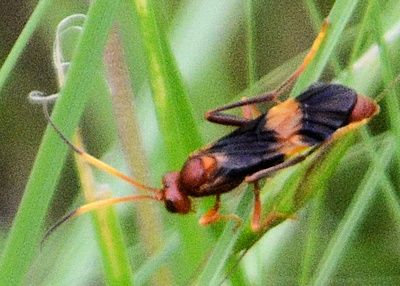 Ichneumon Wasp Trogomorpha arrogans
Ichneumon Wasp Trogomorpha arrogans
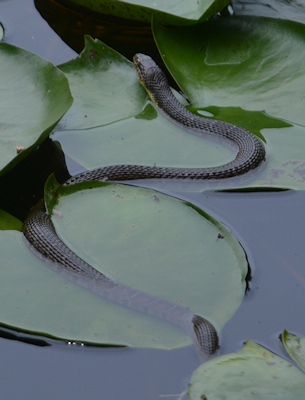 New snake for the lily pond, though not for the place.
New snake for the lily pond, though not for the place.
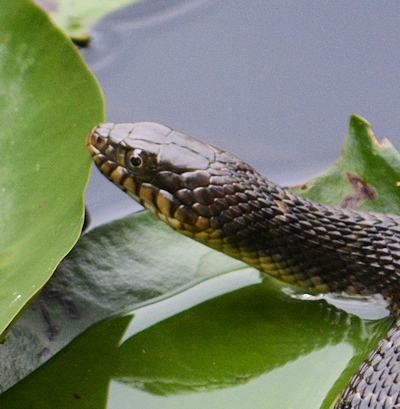 Likely either Natrix erythrogaster transversa or N. erythrogaster flavigaster, the Blotched Water Snake or the Yellow-Bellied Water Snake. The snake didn’t roll over to show me the critical underside.
Likely either Natrix erythrogaster transversa or N. erythrogaster flavigaster, the Blotched Water Snake or the Yellow-Bellied Water Snake. The snake didn’t roll over to show me the critical underside.
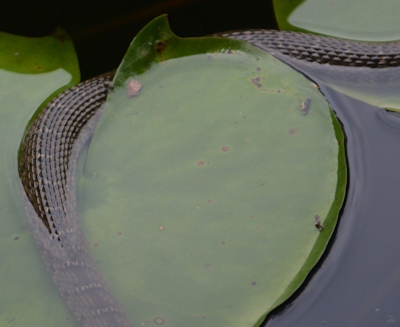 This view clearly shows the faint transverse bands on most of its length.
This view clearly shows the faint transverse bands on most of its length.
We have a lot fewer frogs and tadpoles in the backyard water system than we used to, and I think this snake is responsible. It’s much bigger than the red-lined ribbon snake we’ve had most years, and since it can grow much larger than this, it’s out of scale for the pond-and-stream. Eventually it will have eaten everything it can find here and will go somewhere else to reach its full size.
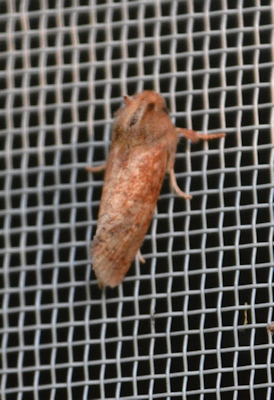
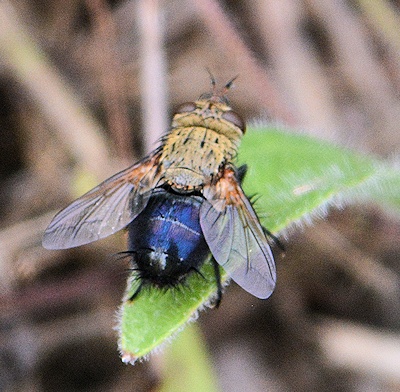
Comment by elizabeth — May 31, 2017 @ 11:58 pm
Name changes are the bane of the amateur natural history buff. In my older field guide to reptiles & amphibians, in the Peterson series, the snake names above are correct. I use that guide because the illustrations are better (IMO), the range maps are larger and more details, and the scientific name is given with the illustration and with the text.
In the newer field guide that supposedly covers the same area, the Audubon series, the photographs are not as good as the drawings in the Peterson series, maps are tiny, scientific names are not given next to the illustrations (or on a facing page) and in addition the book’s organization is screwball–instead of taxonomic groupings, the illustrations are arranged by appearances (plain, striped, patterned, etc.) where adjoining illustrations do not look like similar snakes and have no taxonomic relationship–and the text is back to taxonomic.
But the newer book had the newer names, which I didn’t notice because I already had the names from the older book. In the NEW taxonomy, the genus name has been changed from _Natrix_ to _Nerodia_. I could of course edit the post above and sort of pretend that I knew the right names all along, but…no. The better book was the older book, and so its names (at least for this taxon) had the wrong name for the genus. Always check current sources, just in case someone’s gone and changed a name.
Comment by Mary Anne in Kentucky — June 1, 2017 @ 8:56 am
What a pretty snake. I don’t think I could possibly do pond maintenance–the weeds in the garden say I couldn’t–and I’ve never seen a single snake here on my half-acre.
Thanks for reminding me of BugGuide, which I explored when you mentioned it sometime, and then forgot about, because I don’t try to ID a lot of insects.
Comment by elizabeth — June 1, 2017 @ 7:16 pm
I started in this project as a bi-curious amateur botanist and birder. Pretty serious interest native plants and birds (pure amateur birder, but studied Texas native plants at U.T. Austin as a biology major, and can with difficulty still fight my way through Manual of the Vascular Plants of Texas.) But suddenly I was seeing things I’d never seen, and not knowing what they were triggered the “life list” (or in this case “place list” gene. As the land returned to a healthier state, and more native plants began to thrive, so did their associated invertebrate partners. What ate what plants? What ate what other critters? What did it signify, in terms of restoring a healthier population of plants and wildlife. The next thing I knew I was looking at a wealth of butterflies I’d never noticed (or seen at all) before. And dragonflies. And then damselflies. And wasps. And not all bees were honeybees. Beetles everywhere. True bugs everywhere. I found online help, learned to take pictures specifically for documentation and ID, of everything that held still and some things that didn’t. It began to look possible, with digital photography, to take pictures of everything on the place–every lichen, every grass, every tree (of course) every forb, every spider, every insect, every tick, every rodent…etc. It’s not, really, but the challenge has stretched my knowledge a long way. One spur to that was a book called Women in the Field, out of Texas A&M Press some years back. And it was–and is–fascinating. The fact that I will *never* know every living thing on the place is exciting, stimulating–every time I go outside, I might see something I know nothing about. Wow!
Pond maintenance lessens with a pond’s age, if you set it up so it can develop its own stability. We did a lot more with it in the past. Now we cut the water iris back (I should say Richard cuts the water iris back–that IS a tough job, involving saw, lopping shears, sometimes a hatchet, and extreme care not to cut a hole in the liner!) every few years. Once (sometimes twice) a year there’s an effort to clean out the bottom of the two real ponds (one barely 16 inches deep, the lily pond with a deeper trench in the middle), and we clean fallen leaves from the “stream” section every fall. Aside from that, the plants in the two ponds use up a lot of the nitrogen added by frogs, tadpoles, birds, and other wildlife users. The water source is rainwater (from the sky or all summer from the tanks that collect rainwater from the roof.) It’s not the every day maintenance that a garden needs. When we started, we didn’t have nearly as much storage capacity for rainwater, so we had to use city water to fill and maintain it–and then chemicals to dechlorinate the city water. Now…even city water (used very rarely) loses its chlorination because of the amount of organic material in in the system. As a result, we have frogs breeding in the lily pond (until a big snake comes in and eats the tadpoles.)
Comment by Mary Anne in Kentucky — June 2, 2017 @ 6:27 pm
“Those who hunger for knowledge will never starve.” That comes to me as a quotation but I have no idea where it’s from. But it’s also an appetite that grows by what it feeds on, isn’t it?
Comment by elizabeth — June 3, 2017 @ 8:41 pm
I am a dud when it comes to telling moths from planthoppers!! This happened before; I was sure I had a ‘hopper and it turned out to be a wax moth. Now the first critter up there has been identified on BugGuide.net by Aaron Hunt as a tube moth in the genus _Acrolophus_. Does that look like a moth to you? Probably not, unless you recognize moths that don’t show off their feathery antennae and have their wings at least partly spread. However, it’s a new species for the list and the next time I see a “planthopper” I’ll assume it’s a moth unless it looks like a planthopper I already sortakinda know.